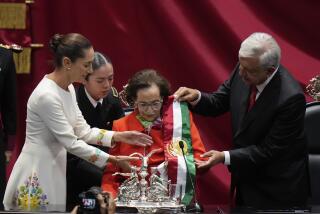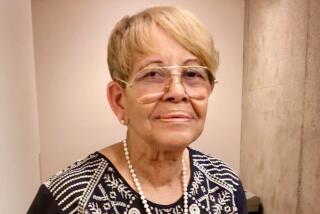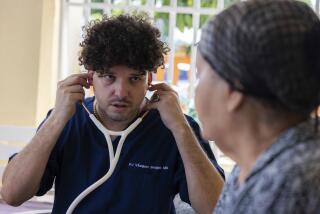A Lifetime of Healing Sick, Helping Poor
- Share via
SAN DIEGO — When Anita Figueredo told her mother she wanted to become a doctor, the pair made a tacit agreement. Anita would get the grades for medical school while her mother earned tuition working as a seamstress in a New York City sweatshop.
There was just one catch. They had to leave their native Costa Rica, which had no medical school, to pursue the goal. It was 1921 and Anita was 5 years old.
“It is unusual that I knew I wanted to be a doctor at such a young age, but that she would listen and make a whole life change based on the wishes of a 5-year-old is truly amazing,” said Dr. Figueredo, now 72.
A surgeon since she was 26, Figueredo still works 30 hours a week in the La Jolla office where she has treated cancer patients since moving to La Jolla in 1947. One of the county’s first female doctors, Figueredo was the first woman in San Diego to earn hospital operating privileges in 1948. It was 15 years before another woman received the same privileges.
Figueredo personified the liberated woman when Gloria Steinem was still a toddler. She even kept her maiden name after she married. She has successfully combined career and marriage with raising nine children, never considering herself extraordinary. Even pregnancy failed to faze her.
“When the baby started to kick her away from the operating room table, she’d say ‘Well, I guess it’s about time to deliver,’ “said her husband of 46 years, retired pediatrician Bill Doyle. “Two weeks later, she’d be back at work,”
A Special Role Model
But Figueredo was not without a role model. She has long admired another determined career woman who lived halfway around the world; Mother Teresa took her work as seriously as the petite doctor. Their friendship has spanned 30 years.
Figueredo first wrote to Mother Teresa in 1957 after reading about her work. To her surprise, the nun wrote back. They continued to correspond sporadically until Mother Teresa first spoke in San Diego in 1960.
“This little nun in a wrinkled sari got up to address us,” Figueredo said. “She’s told me since she was very nervous. It was her first talk outside India.”
When Figueredo introduced herself following the speech, she didn’t expect the nun to remember her.
“She said ‘Anita! I prayed that we would meet.’ My hair stood up on end. It was just instant friendship. I couldn’t convince my friends I hadn’t met her before.” They talked for hours.
Figueredo has visited the nun many times since, often urging her to return to San Diego, which Mother Teresa finally did last month. First, the nun spoke at the University of San Diego, where Figueredo is a trustee, then she went to Tijuana to visit members of her order, Missionaries of Charity, who are supervising construction of a shelter for homeless men there.
Figueredo also works with the poor--she convinced Mother Teresa to establish a home for indigents in Tijuana--and for years has provided free treatment and medicine to indigents in the border city.
While the world considers Mother Teresa a living saint, many San Diegans offer similar praise to Figueredo. Her longtime friend and La Jolla neighbor, Sara Finn, said that Figueredo’s encouragement helped her launch a public relations career in the early 1960s.
Despite her progressive life style, Figueredo never considered herself unusual. She merely possessed unfailing devotion to one goal--becoming a doctor. That she knew at age 5 that she wanted to practice medicine is not unusual, considering her decisive, determined, unflappable attitude toward just about everything else.
Finn remembers one time when the always-prompt doctor was late for a luncheon. When she arrived, she explained without a quaver in her voice that she had rolled her car three times on the way to see patients in the hospital. A police officer urged her to see a doctor, Finn said, but Figueredo said that she had to make a lunch engagement.
The women in attendance gasped, but Figueredo hushed their concerns.
“The only thing out of place was a runner in her stocking. She sat down to lunch just like it was any other day,” Finn said.
From age 7, Figueredo attended boarding school, which her mother paid for by working long hours in New York City. When she went to grammar school in Upstate New York, her mother visited during weekends, but after she transferred to Southern Seminary in Virginia at age 12, they saw each other only on holidays. Yet they didn’t feel slighted.
“We were in it together. She was doing her bit and I was doing mine and together we would make it work,” she said.
Figueredo comes from a family of strong women, so it does not seem unusual that her divorced mother, Sarita Villegas, would leave her comfortable, upper-middle-class life in Costa Rica with only $24 and no friends in America to help her daughter pursue a career.
Her aunt, at 19, became the first woman in Costa Rica to attend law school. Another aunt restructured the Costa Rican nursing profession.
Figueredo said everyone tried to dissuade Sarita from going to New York, but she was determined. When they arrived at Ellis Island, even the ambassador from Costa Rica attempted to send Anita and her mother home.
“She had to take on the world,” Figueredo said. “She always had to stand up to people much more than I. I had it good. Everyone was nice to me.”
Neither Figueredo nor her mother considered their career plans unusual, despite the reaction of others. At the Southern Seminary, “everybody thought I was crazy. They said, ‘why do you want to go to school for 18 years?’ So I asked them, ‘What are you going to be doing 18 years from now?’ Well, they didn’t rightly know.”
Only once did the doctor question her decision to pursue medicine--the day she glimpsed a cadaver.
“You knew when they uncovered it that it was going to be some gruesome-looking person. For the first time I thought, ‘What if I don’t like this?’ ”
She overcame her distaste, eventually graduating with three other women in a class of 100 from Long Island College of Medicine. She became the first female surgeon to complete a residency at Memorial Sloan-Kettering Cancer Center in Manhattan. Look Magazine celebrated her accomplishment with a four-page photo essay in December, 1942.
As a female resident, Figueredo encountered prejudice, but never let it ruffle her. One 7-year-old boy looked at her and said, “You can’t fool me! Everybody knows you have to be a man to be a doctor.”
Another time, a man admitted to Sloan-Kettering for cancer surgery balked when he learned that a woman was going to operate on him.
“I empathized with him,” said Figueredo, a slight woman barely 5 feet tall. “You come into a hospital to be operated on by a famous surgeon and in comes this little girl. ‘Get me a real doctor’ was an understandable response. But Dr. Pack (the chief surgeon) said ‘She’s my choice. Either you get operated on by her, or you go somewhere else.’ ”
The man stayed.
The young doctor took the incident in stride, as she continues to do in similar situations today. Her faith and refusal to acknowledge adversity have helped her survive and achieve. Her son once noted, humorously, that she actually wears rose-colored glasses.
More to Read
Sign up for Essential California
The most important California stories and recommendations in your inbox every morning.
You may occasionally receive promotional content from the Los Angeles Times.













